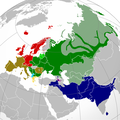檔案:Indo-European branches map.png

Yi-lám thai séu: 599 × 600 chhiong-su. Khì-thâ kié-sak-thu: 240 × 240 chhiong-su | 479 × 480 chhiong-su | 767 × 768 chhiong-su | 1,023 × 1,024 chhiong-su | 2,045 × 2,048 chhiong-su | 2,934 × 2,938 chhiong-su.
Ngièn-pún tóng-on (2,934 × 2,938 chhiong-su, vùn-khien thai-séu: 2.16 MB, MIME lui-hîn: image/png)
Vùn-khien li̍t-sṳ́
Tiám-khim ngit-khì / sṳ̀-kiên lòi chhà-khon tông-sṳ̀ chhut-hien-ko ke vùn-khien.
| Ngit khì / Sṳ̀-kiên | Suk-lio̍k-thù | Vì-thu | Yung-fu | Yi-kien | |
|---|---|---|---|---|---|
| tông-chhièn | 2022年9月26日 (Yit) 03:43 |  | 2,934 × 2,938(2.16 MB) | Alexikoua | minor fixes |
| 2022年3月30日 (Sâm) 15:58 |  | 2,934 × 2,938(1.74 MB) | Whoop whoop pull up | Whoops, wrong file! | |
| 2022年3月30日 (Sâm) 15:37 |  | 2,048 × 2,048(980 KB) | Whoop whoop pull up | Misc fixes (Russian minority in Svalbard & Israel, Slovenian in SE Carinthia, Greek in N Epirus, Aromanians/Megleno-Romanians, Swedish essentially extinct in Estonia, etc. | |
| 2021年12月22日 (Sâm) 09:37 |  | 2,934 × 2,938(1.74 MB) | Ahmet Q. | Reverted to version as of 19:55, 23 August 2021 (UTC)seek consensus for your changes | |
| 2021年11月25日 (Si) 20:40 |  | 2,934 × 2,938(2.16 MB) | Alexikoua | rv elimination of Greek minority in Albania | |
| 2021年8月23日 (Yit) 19:55 |  | 2,934 × 2,938(1.74 MB) | Ahmet Q. | Rv false edit summary. Overrepresentation of Greeks in Turkey, Albania and Ukraine. Unexplained removal of Romanian in Serbia. Overall deterioration of the original file. Seek consensus for your changes. | |
| 2021年8月7日 (Liuk) 16:16 |  | 2,934 × 2,938(2.16 MB) | Demetrios1993 | Addition of Arbereshe linguistic minority in Sicily. Addition of Serbian, Bosnian, and Gorani linguistic minorities in Kosovo. Addition of Greek linguistic minorities in Italy, Albania, Turkey, and Ukraine. Including some other minor corrections. | |
| 2020年11月19日 (Si) 17:00 |  | 2,934 × 2,938(1.74 MB) | Golden | update Armenian | |
| 2018年3月31日 (Liuk) 18:42 |  | 1,479 × 1,479(574 KB) | Maphobbyist | Removed area that exactly corresponds to the non-Indo European Lezgi linguistic area. | |
| 2016年9月6日 (Ngi) 21:37 |  | 1,479 × 1,479(620 KB) | Rob984 | Georgia and Azerbaijan aren't majority multilingual. Older generations speak Russian from the Soviet era but now English is taught mainly in place of Russian. More people speak English in Finland, yet that isn't coloured. Also corrections to Celtic are... |
Vùn-khien yung-chhú
Hâ poi ke 1-chak ya̍p-mien lièn-chiap to pún vùn-khien:
Chhiòn-vet tóng-on sṳ́-yung chhong-khóng
Hâ-lie̍t khì-thâ Wiki chûng sṳ́-yung liá-chak tóng on:
- ast.wikipedia.org ke sṳ́-yung chhong-khóng
- ban.wikipedia.org ke sṳ́-yung chhong-khóng
- be-tarask.wikipedia.org ke sṳ́-yung chhong-khóng
- be.wikipedia.org ke sṳ́-yung chhong-khóng
- bg.wikipedia.org ke sṳ́-yung chhong-khóng
- cs.wikipedia.org ke sṳ́-yung chhong-khóng
- da.wikipedia.org ke sṳ́-yung chhong-khóng
- de.wikipedia.org ke sṳ́-yung chhong-khóng
- en.wikipedia.org ke sṳ́-yung chhong-khóng
- en.wikiversity.org ke sṳ́-yung chhong-khóng
- es.wikipedia.org ke sṳ́-yung chhong-khóng
- et.wikipedia.org ke sṳ́-yung chhong-khóng
- eu.wikipedia.org ke sṳ́-yung chhong-khóng
- fa.wikipedia.org ke sṳ́-yung chhong-khóng
- fi.wikipedia.org ke sṳ́-yung chhong-khóng
- frr.wikipedia.org ke sṳ́-yung chhong-khóng
- fr.wikipedia.org ke sṳ́-yung chhong-khóng
- gl.wikipedia.org ke sṳ́-yung chhong-khóng
- gu.wikipedia.org ke sṳ́-yung chhong-khóng
- gv.wikipedia.org ke sṳ́-yung chhong-khóng
- he.wikipedia.org ke sṳ́-yung chhong-khóng
- hy.wikipedia.org ke sṳ́-yung chhong-khóng
- hyw.wikipedia.org ke sṳ́-yung chhong-khóng
- ilo.wikipedia.org ke sṳ́-yung chhong-khóng
- incubator.wikimedia.org ke sṳ́-yung chhong-khóng
- io.wikipedia.org ke sṳ́-yung chhong-khóng
- it.wikipedia.org ke sṳ́-yung chhong-khóng
Kiám-sṳ liá vùn-khien ke kiên-tô chhiòn-vet sṳ́-yung chhong-khóng.



